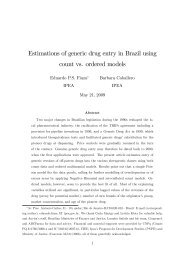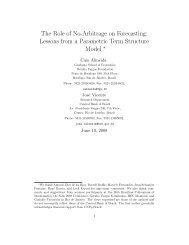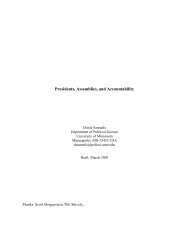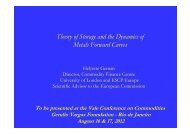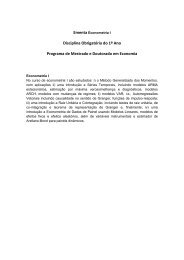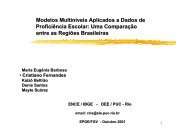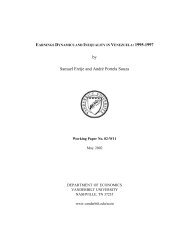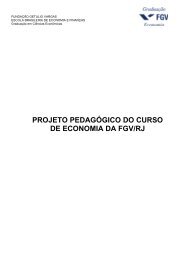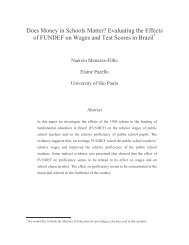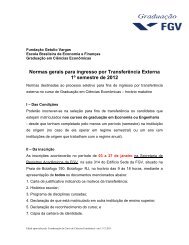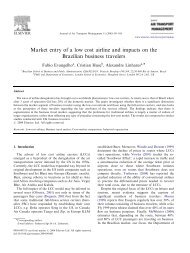View - EPGE/FGV
View - EPGE/FGV
View - EPGE/FGV
Create successful ePaper yourself
Turn your PDF publications into a flip-book with our unique Google optimized e-Paper software.
Sustainable Miracles: Protection and<br />
Competition in the Brazilian Oil Industry ∗<br />
Benjamin Bridgman † Victor Gomes ‡ Arilton Teixeira §<br />
June 8, 2005<br />
Abstract<br />
It is often suggested that competition improves productivity, however, the underlying<br />
support for this idea is surprisingly thin. This paper presents a case study<br />
examining the effects of a change in the competitive environment on productivity<br />
at the Petrobras, Brazil’s state-owned oil company. Petrobras had a legal monopoly<br />
on production, refining, transportation and importation of oil in Brazil until it was<br />
removed in 1995. Even though Petrobras continues to have a de facto monopoly, the<br />
end of legal monopoly labor productivity growth rate more than doubled. A growth<br />
accounting of the industry shows that between 1977 and 1993 output growth rate<br />
(and productivity growth rate) is explained by the accumulation of capital, while<br />
Total Factor Productivity (TFP) decreased.<br />
Between 1994 and 2000 labor productivity<br />
growth rate is completely explained by the growth rate of T F P .<br />
The<br />
results suggest that the threat of competition alone is sufficient to improve productivity.<br />
They also provide evidence that restricting competition help cause Brazil’s<br />
depression of the 1980s.<br />
∗ Preliminary. We would like to thanks James Schmitz Jr. for comments and Patrícia Moura da<br />
Silva for research assistance. The views expressed in this paper are solely those of the authors and not<br />
necessarily those of the U.S. Bureau of Economic Analysis or the U.S. Department of Commerce.<br />
† Bureau of Economic Analysis, Benjamin.Bridgman@bea.gov.<br />
‡ Capixaba Research Foundation and UCSD, vgomes@econ.ucsd.edu.<br />
§ Capixaba Research Foundation, arilton@fucape.br.<br />
1
1 Introduction<br />
It is often suggested that competition improves productivity. It is an idea at least as old<br />
as Adam Smith and is cited as support for a number of policy interventions including<br />
antitrust enforcement, deregulation of markets and privatization. Some economists have<br />
argued that restrictions on competition are an important source of differences in national<br />
income. (Parente and Prescott [18], Herrendorf and Teixeira [10])<br />
Given its long pedigree, the underlying support for this idea is surprisingly thin. The<br />
theoretical literature is ambiguous. While some models predict increasing productivity<br />
in response to competition (For example, Holmes and Schmitz [9]), others predict the<br />
opposite. (For example, Martin [15] and Horn, Lang and Lundgren [9])<br />
The empirical literature is also ambiguous.<br />
A number of authors have examined<br />
the data from public sector reforms such as privatization, deregulation of markets, and<br />
foreign competition. While many studies find improvements in productivity, some find<br />
the opposite. (See Megginson and Netter [16] for a survey.)<br />
One challenge in testing this relationship is the measurement of competition. Common<br />
measures such as market share suffer from confounding influences. A firm may have a<br />
large market share because it is a very productive firm and can sell its output at a low<br />
price or because it has monopoly power. More direct measures such as markups require<br />
data on costs that are typically not available.<br />
Another challenge is that reforms that increase competition are typically part of a<br />
comprehensive package, making it difficult to identify how competition affects productivity.<br />
For instance, a firm may be privatized at the same time as its markets are liberalized<br />
and trade barriers are reduced.<br />
Therefore, it is difficult to disentangle the effects of<br />
ownership change from those of market changes.<br />
This paper presents a case study examining the effects of a change in the competitive<br />
environment on productivity at the Petrobras, Brazil’s state-owned oil company. Petrobras<br />
had a legal monopoly on production, refining, transportation and importation of oil<br />
in Brazil until it was removed in 1995.<br />
Using a case study allows us to avoid the issue to selecting a proxy for the degree<br />
2
of competitiveness. This strategy has used to examine a number of instances when the<br />
competitive environment changed, including reduced trade barriers, deregulation, privatization<br />
(Schmitz and Teixeira [19]), and changes in technology (Galdon and Schmitz [8]).<br />
We have selected a case that avoids disentangling the effects of multiple policy changes.<br />
The Petrobras reform was simply the removal of a legal monopoly and was not accompanied<br />
by any other changes. Ownership was not changed, nor are there plans to do<br />
so. Therefore, any changes in productivity cannot be attributed to other (direct) policy<br />
changes.<br />
We find a large increase in labor productivity growth after 1994. Between 1977 and<br />
1993 labor productivity grew at an annual average of 4.3 percent. Between 1994 and 2000<br />
it grew at an annual average of 11.8 percent. Not only did growth more than double,<br />
the sources of the growth changed. Labor productivity growth prior to 1995 was due to<br />
capital accumulation (with T F P decreasing) while almost all growth after 1994 was due<br />
to T F P growth (as capital stock fell).<br />
These gains all the more impressive given how little competition Petrobras actually<br />
faced after losing its legal monopoly. It still maintains a dominant position. For example,<br />
Petrobras still has over 97% of Brazil’s refining capacity. Its advantages as a large<br />
incumbent made it difficult for competitors to enter the market. Unlike previous studies<br />
where firms face a declining market as a result of competition, the threat of competition<br />
was sufficient to generate significant productivity gains.<br />
The experience of Petrobras gives some insight into several areas of economics.<br />
First, economists should be cautious when using market shares as a indicator of competitiveness.<br />
The prospect of competition resulted in changes in Petrobras’s productivity.<br />
However, market concentration indicators changed very little. As a proxy for competition,<br />
they would have missed a shift in the competitive environment.<br />
Second, privatization may not be required to improve the performance of public enterprizes.<br />
There are no plans to privatize the company and it is unlikely to occur in the<br />
future given the political sensitivity of such a move. When privatization is not politically<br />
viable, increasing competition in the markets of state-owned firms can provide an avenue<br />
3
for improving performance. The results lend support to the view that the competitive<br />
environment is an important determinant of productivity, regardless of ownership. (See<br />
Bartel and Harrison [1] for a discussion of the environment vs. ownership issue.)<br />
Third, the results provide support for the idea that closing off competition in the 1970s<br />
contributed to Brazil’s poor economic performance in the 1980s. Brazilian T F P began<br />
to fall after the government expanded state-owned enterprizes (including Petrobras) and<br />
raised trade barriers during the 1970s as a strategy to keep the economy growing despite<br />
the recession that hit the main capitalist economies and the slowdown in the productivity<br />
growth rate. 1<br />
2 The Oil Industry in Brazil<br />
Since oil was discovered in Bahia in 1938 until the 1990s, the Brazilian oil industry has<br />
been characterized by increasing government intervention 2 .<br />
From 1938 to 1954, the government sought to develop the oil sector through private<br />
companies while serving as a regulator through the National Petroleum Council (henceforth<br />
CNP, from its Portuguese name). But the private sector did not show much interest<br />
since the reserves belonged to the CNP and there was no legislation to guaranteing investors<br />
the benefits of exploration. In addition, the cost of extracting oil in Brazil was<br />
high compared to that of the Middle East. 3<br />
In 1954, the government created the state-owned monopoly Petrobras to explore, extract<br />
and refine petroleum. (Existing private refining companies were allowed to continue<br />
operating but could not expand.) This policy was part of a larger import substitution<br />
policy to develop the industrial sector (Kingstone [13]).<br />
The monopoly power of Petrobras was extended to the import and export of oil in<br />
the 1963. Between the creation of Petrobras and 1970s, domestic prices were essentially<br />
equal to the international prices plus a Federal tax. In an attempt to shield the domestic<br />
1 See Bugarin, et al. [2, 3].<br />
2 See Campos [4].<br />
3 See Ministerio das Minas e Energia [5] and Serour [20].<br />
4
economy from the oil shocks, domestic prices became disconnected from international<br />
prices in 1977 and based on a measure of domestic production cost.<br />
In 1988, the process of increasing government intervention reached its apex when<br />
Petrobras’s monopoly rights were guaranteed in the new Brazilian constitution.<br />
By the beginning of the 1990s, the process of privatization and deregulation in the<br />
Brazilian economy reached the oil sector. A constitutional amendment (Constitutional<br />
Amendment Number 9) approved by the Brazilian Congress in 1995 ended the monopoly<br />
rights of Petrobras over production, refining, importing and exporting. Though many<br />
other sectors were privatized, the Brazilian government did not propose privatizing Petrobras.<br />
The end of monopoly was the biggest concession that the government could manage<br />
to get from the Brazilian Congress 4 .<br />
With the change in the Brazilian constitution, a new regulatory framework was set up<br />
for the oil sector. In September 1997, a new law was approved by the Congress allowing<br />
any firm to produce, transport, refine import and export petrol in Brazil. In 1998, two<br />
government decrees set up a regulatory structure in the sector and the National Energy<br />
Policy Council (CNPP) to advise on the norms and rules for the sector. It created the<br />
National Petroleum Agency (ANP henceforth) to regulate the sector. Finally, it set up<br />
auctions to sell the rights to extract oil in Brazil. In 1998, Petrobras were given the rights<br />
to the fields it has already started exploiting, keeping 7% of potential areas. This was<br />
called Round 0. In 1999, auctions began to sell exploitation rights for the remaining areas<br />
(Kingstone [13]).<br />
3 Productivity at Petrobras<br />
In this section we will analyze Petrobras’s productivity performance in response to the<br />
loss of its legal monopoly.<br />
Even though the change in the monopoly status of Petrobras happened in 1995, discussion<br />
of the policy change began earlier. When dating the beginning of a reform, the<br />
4 Kingstone [13] explains in detail how President Fernando Henrique Cardoso overcame opposition in<br />
the Congress to end the constitutional monopoly rights of Petrobras<br />
5
date of the legal change many not be the most relevant date. Managers in the reformed<br />
industry may have anticipated the reform and introduced changes prior to the reform<br />
becoming official. (This is sometimes called the “announcement effect.”)<br />
In a study of the impact of privatization in the Brazilian iron ore sector Schmitz and<br />
Teixeira [19] argue that 1989 should be set as the beginning of the reform. It was in<br />
1989 that a new Brazilian president was elected promising to privatize and deregulate the<br />
economy to increase competition (Kingstone [13] and Velasco [12]).<br />
We date the beginning of the reform in the oil industry as 1994. The policy to remove<br />
the monopoly originated with President Fernando Henrique Cardoso, who took office in<br />
January 1994. In January 1995, he sent an amendment to the Congress (Amendment #9)<br />
to eliminate Petrobras’s monopoly and Congress approved it in September 1995. Since<br />
discussion began before the amendment was sent to the Congress, we argue that 1994 is<br />
the year that the reform of Petrobras began.<br />
In what follows, we will argue that the end of Petrobras’s monopoly rights and the<br />
threat of new competitors had a impact on its productivity performance. First, we will<br />
look at a measure of technological progress, total factor productivity (T F P ), of Petrobras.<br />
T F P is computed using a Cobb-Douglas production function given by<br />
Y t = A t K θ t M α t N (1−θ−α)<br />
t (1)<br />
where K t is the aggregate capital stock, M t is the amount of material, N t is the number of<br />
employees, θ is the capital share, α is the labor share and A t is the total factor productivity<br />
(henceforth T F P ).<br />
Using the balance sheets of Petrobras and data available at the ANP we computed<br />
total amount of oil produced, the capital stock, the number of employees for each year<br />
and the labor share in the period 1976 and 2000. The average labor share in the period<br />
equal to 0.2 was used as the calibrated value of α. We did not have data for material<br />
so we use a proxy. We assume the total amount of material is a fixed proportion of the<br />
6
number of wells. Behind this assumption is the idea that the amount of material used is<br />
defined by technology and therefore can not be easily substituted. Using data available<br />
for the United States we computed the share of capital equal to 0.45 5 Therefore the share<br />
of material was set equal to 0.35. 6 . The results are showed in Figure 1<br />
Figure 1: Total Factor Productivity of Petrobras, 1976-2000<br />
140<br />
130<br />
120<br />
Beginning of<br />
Privatization<br />
Beginning the<br />
Discussion to<br />
End Monopoly<br />
110<br />
1976 = 100<br />
100<br />
90<br />
80<br />
70<br />
60<br />
1975 1980 1985 1990 1995 2000<br />
Years<br />
The second half of the 1970s are characterized by a deep and abruptly fall in T F P<br />
of Petrobras. The TFP index falls from 100 in 1976 to 63 in 1980. This fall in T F P of<br />
Petrobras was in line with the fall in the aggregate Brazilian T F P (Bugarin, et al. [3]).<br />
From 1980 until 1993 T F P shows no sustained gains. This period corresponds to the<br />
time Petrobras was a legal monopolist. In fact, its monopoly power was increased in this<br />
period. In 1988 Petrobras’s monopoly rights became a constitutional guarantee rather<br />
than an ordinary law. On the other hand, from 1994 until 2000 T F P grows very fast. In<br />
five years T F P almost doubled, increased 82%. This is the period when a constitutional<br />
amendment abolished the monopoly rights of Petrobras, opening the sector to private<br />
5 We use the KLEM data set for Oil and Gas Extraction (Industry Group 4) described in Jorgenson<br />
and Stiroh [11]. The labor share for Petrobras was nearly identical to that of the United States.<br />
6 See the Appendix for details on the data<br />
7
companies.<br />
The results shown in Figure 1 could be driven by the assumption about materials. To<br />
check this possibility, we assumed that θ, the capital share in Equation 1, was equal to<br />
0.8 and that material share was equal to zero. In this case we do not need to use any<br />
proxy for material. The results of T F P computed with and without materials in the<br />
production function are shown in Figure 2<br />
Figure 2: Total Factor Productivity of Petrobras, 1976-2000<br />
140<br />
130<br />
TFP With Material<br />
TFP Without Material<br />
120<br />
110<br />
1976 = 100<br />
100<br />
90<br />
80<br />
70<br />
60<br />
50<br />
1975 1980 1985 1990 1995 2000<br />
Years<br />
Excluding materials changes the magnitude of TFP’s movements, but does not affect<br />
its pattern. In what follows, we will keep materials in the production function since we<br />
know from the U.S. data that material are a input in the oil sector.<br />
The next step is to study the sources of growth of production and labor productivity<br />
(henceforth productivity). First we perform a growth accounting of growth rate of output.<br />
Logging Equation 1 and rearranging the terms we have:<br />
8
[log (Y t+s ) − log (Y t )] /s = [log A t+s − log A t ] /s + θ [log (K t+s ) − log (K t )] /s + (2)<br />
α [log (M t+s ) − log (M t )] /s + (1 − θ) [log (N t+s ) − log (N t )] /s<br />
The left hand side of Equation 3 gives us the contribution of technological progress,<br />
accumulation of capital, material and number of workers employed to output growth.<br />
As we said before, using a capital share of 0.45 and labor share equal to 0.2 the growth<br />
accounting in the two subperiods is given in Table 1.<br />
Table 1 - Growth Accounting of Petrobras’s Output(%)<br />
Period change in Y due to T F P due to K due to M due to N<br />
1977-1993 8.0 -2.0 5.8 3.4 0.7<br />
1994-2000 9.3 8.6 0.3 0.9 -0.5<br />
The growth rate of output increased in the period without monopoly. But the major<br />
difference comes from the sources of growth in the two subperiods.<br />
In other words,<br />
the engine of growth changed. In the first period, output grew almost entirely due to<br />
increasing capital and materials. There is no technological progress. In fact technology<br />
regressed (see also Figure 1). This result is similar to the the findings of Bugarin, et al. [3]<br />
for the aggregate Brazilian economy. They found that to keep the economy growing after<br />
the oil shocks of the 1970s the government encouraged capital accumulation, despite the<br />
lack of technological progress.<br />
To pursue the objective of keeping the growth rate of<br />
the Brazilian economy the government subsidized private companies and had SOEs, like<br />
Petrobras, increase investment. (We elaborate on this point below.).<br />
In the second subperiod, the major source of growth was T F P . The growth rate of<br />
T F P increased a dramatically and it explains 93% of the growth rate of output.<br />
We also perform a growth accounting of productivity (labor productivity). We divide<br />
Equation 1 by N t than take logs and rearrange the terms to get<br />
9
[<br />
θ log<br />
[ ( )<br />
Yt+s<br />
log<br />
N<br />
( ) t+s<br />
Kt+s<br />
− log<br />
N t+s<br />
(<br />
Yt<br />
− log<br />
(<br />
Kt<br />
N t<br />
)]<br />
/sα<br />
)]<br />
/s = [log A t+s − log A t ] /s + (3)<br />
N t<br />
[ ( ) ( )]<br />
Mt+s Mt<br />
log − log /s<br />
N t+s N t<br />
Using the same capital share and the share of material as specified above (θ equal to<br />
0.45 and α equal to 0.35) we get the following results.<br />
Table 2 - Growth Accounting of Petrobras’s Labor Productivity (%)<br />
Period change in Y/N due to T F P due to K/N due to M/N<br />
1977-1993 4.3 -2.0 4.1 2.2<br />
1994-2000 11.8 8.6 1.4 1.8<br />
Table 2 gives us a better idea of the engine of growth. First, we see that growth rate<br />
of productivity more than doubled after the end of monopoly. In the first subperiod,<br />
productivity grew almost completely due to an increases in K/N and M/N while T F P<br />
fell. In the second, T F P became the major source of growth.<br />
Even though the increase of T F P started in 1994 (Figure 1) some other possibilities<br />
are open to explain this increase.<br />
One possibility is that technology advanced faster<br />
after 1994. To eliminate this possibility, we compare the Brazilian industry to that of the<br />
United States. Since we do not have enough data to compute T F P in the U.S. oil industry,<br />
we examine labor productivity. We compute the labor productivity of Petrobras relative<br />
to the U.S. labor productivity.<br />
If technology advanced faster after 1994 the relative<br />
productivity should not change since we would expect the United States industry to<br />
implement the new technology and experience the similar growth in the labor productivity.<br />
Figure 3 plots two series. One is the labor productivity of Petrobras (Labor Productivity).<br />
The other is the labor productivity of Petrobras relative to the United States<br />
(Relative Labor Productivity). Both indices set to 100 in 1980. We analyze three subperiods.<br />
First, from 1977 until 1980 relative productivity is constant. Second, from 1980<br />
10
Figure 3: Brazilian Labor Productivity Relative to the United States (1980=100), 1976-<br />
2000<br />
700<br />
600<br />
500<br />
Labor Productivity<br />
1980 = 100<br />
400<br />
300<br />
200<br />
100<br />
Relative<br />
Labor<br />
Productivity<br />
0<br />
1975 1980 1985 1990 1995 2000<br />
Years<br />
until 1985 relative productivity increased going from 100 to 200. Third, from 1985 until<br />
1993 relative productivity is constant. Finally, after 1994 when relative productivity<br />
grows quickly. Relative productivity more than doubled, going from 200 in 1995 to 500<br />
in 1999.<br />
To help us analyze these four subperiods, we recalculate Table 2 breaking it in smaller<br />
subperiods. The results are in Table 3.<br />
(%)<br />
Table 3 - Growth Accounting of Petrobras’s Relative Labor Productivity<br />
Period change in Y/N due to T F P due to K/N due to M/N<br />
1977-1980 -6.4 -11.6 5.7 -0.5<br />
1981-1985 16.4 7.1 6.2 3.1<br />
1986-1993 2.0 -2.8 2.0 2.9<br />
1994-2000 11.8 8.6 1.4 1.8<br />
11
In the first subperiod, relative productivity is constant. Labor productivity for both<br />
Petrobras and the United States decline. Recall from Table 3 that Petrobras’s productivity<br />
did not fall as much as T F P because capital and materials growth compensated.<br />
In the second subperiod, 1980-1993, relative productivity as well as T F P increased.<br />
The growth in the relative productivity is due to increasing productivity at Petrobras<br />
(the U.S. labor productivity is constant during this subperiod). There are two sources of<br />
growth. Both TFP and the K/N ratio increased. Even though T F P was growing rapidly,<br />
more than 75% of the growth of labor productivity is due to the rising K/L and M/N.<br />
In the third subperiod, from 1986 until 1993, the United States’s and Petrobras’s<br />
productivity are growing at the same rate. Note that Petrobras’s productivity is growing<br />
only due to rising K/N and M/N. TFP shows a negative growth rate. One possibility<br />
to explain this negative growth rate is the increase in barriers to entry in the oil sector.<br />
The new constitutional guarantee in 1988 reduced the amount of competition Petrobras’s<br />
managers anticipated, since changing the constitution is more difficult than changing a<br />
law.<br />
Finally, in the last subperiod from 1994 until 2000, relative productivity grows due to<br />
growth in the productivity of Petrobras (U.S. productivity is constant). As noted above,<br />
the main change with respect to the growth observed in the period 1980-1985 is the engine<br />
of growth. Between 1980 and 1985 the main source of growth is capital accumulation and<br />
material used per worker. After 1994, TFP is the main source of growth.<br />
4 Competition and Productivity<br />
In this section, we examine the implications of the results for relationship between competition<br />
and productivity. We argue that the results show that the threat of competition,<br />
even absent actual competition, can increase productivity. We discuss the implications<br />
of this finding for studying competition and designing reforms.<br />
The reform we study is notable for how minimal it was compared to its effects. Even<br />
though Petrobras lost its de jure monopoly, de facto Petrobras is still a monopolist,<br />
12
particularly in the refining and import sector 7 (Palacios [17] and Lewis [14]).<br />
There was very little entry into the oil extraction market. Table 4 shows the number<br />
of fields that Petrobras and other companies bought in each round that took place since<br />
1998. The last column shows that share of all fields purchased over the period. Petrobras<br />
has at least an interest in nearly three quarters of new concessions. Even though the<br />
number of areas bought by other companies has increased, they have had little success<br />
discovering oil.<br />
According to Kingstone [13], this has been used as an indicator that<br />
Petrobras kept all the most promising areas in Round 0.<br />
Table 4 - Purchase of Rights of Exploitation 1998/2004<br />
Measuring Entry – Number of Fields<br />
1998 1999 2000 2001 2002 2003 2004 Share 98-04 (%)<br />
Petrobras 96 1 0 7 3 85 57 54.5<br />
Petrobras with others 0 6 11 7 5 0 50 17.3<br />
Others 19 5 10 19 13 16 47 28.2<br />
Total 115 12 21 33 21 101 154 100<br />
Source: ANP<br />
Petrobras also has nearly all the refining market. Table 5 shows the percentage of<br />
Petrobras in the total refining capacity between 1997 and 2003. Petrobras has 98% of the<br />
Brazilian installed capacity to refine oil during the entire period. The end of the monopoly<br />
did not affect Petrobras’s share in the industry (even though refining is a specific sector<br />
of the industry, these figures do not change if we look at other sectors of the industry<br />
(production, export, import, distribution) 8 . See Lewis [14] and Ellsworth and Gibbs [7]).<br />
7 There is still barriers to entry and the sector is quite risky due to government intervention. For<br />
example, currently the Brazilian government is blocking a price increase in the domestic market in<br />
response to the high prices of oil in the international market.<br />
8 Maintaining control of exploration and refining gives Petrobras control of the gasoline market. There<br />
is little international trade in gasoline since it must be formulated to local standards, which prevents<br />
taking full advantage of economies of scale in transportation.<br />
13
Table 5 - Share of the Installed Refining Capacity 1997/2003 (%)<br />
Period 1997 1998 1999 2000 2001 2002 2003<br />
Petrobras 98.7 98.7 98.5 98.6 98.6 98.3 98.4<br />
Other Companies 1.3 1.3 1.5 1.4 1.4 1.7 1.6<br />
Source: Anuario Estatistico (ANP).<br />
An implication of the analysis is that economists should be cautious when using market<br />
shares as a indicator of competitiveness.<br />
The prospect of competition resulted in<br />
changes in Petrobras’s productivity. However, market concentration indicators changed<br />
very little. As a proxy for competition, they would have missed a shift in the competitive<br />
environment.<br />
One of the most popular indices of concentration of firms in an industry is the<br />
Herfindhal-Hirschman Index (HHI). It is given by the sum of the square of the market<br />
share of all companies in a given industry. It lies between zero and one, higher numbers<br />
indicating more concentration in the industry. Using the data in Table 5 we computed<br />
the HHI.<br />
Even though we do not have data covering the period before 1997, when Petrobras<br />
was a monopolist, it could not be far from the numbers shown in Table 6 since the upper<br />
bound for HHI is one. 9<br />
Table 6 - Herfindhal-Hirschman Index (HHI) in the Refining Sector 1997/2003<br />
Period 1997 1998 1999 2000 2001 2002 2003<br />
HHI 0.97 0.97 0.97 0.97 0.97 0.97 0.97<br />
The HHI was unchanged and showed a extremely concentrated market over the reform<br />
period. Using the HHI, one would conclude that the reform was a failure since Petrobras<br />
9 Since 1954, four private companies have operated in the refining sector. They were allowed to operate<br />
since they were operating prior to the creation of Petrobras (Serour [20])<br />
14
did not cede any of its market share. However, it was successful in increasing productivity.<br />
Studies using market share data will miss threats of competition, which can have real<br />
effects.<br />
Another implication is that privatization is not be required to improve the performance<br />
of public enterprises. There are no plans to privatize Petrobras and it is unlikely to occur<br />
in the future. Petrobras is one of a set of politically sensitive state enterprises, called<br />
the “Crown Jewels.” It is also a significant source of revenues for both state and Federal<br />
governments. The removal of the monopoly guarantee alone generated significant political<br />
conflict. (Kingstone [13])<br />
The results lend support to the view that the competitive environment is an important<br />
determinant of productivity, regardless of ownership. In fact, many instances when only<br />
ownership was changed have not resulted in an improvement in performance. (Bartel and<br />
Harrison [1]) When privatization is not politically viable, increasing competition in the<br />
markets of state-owned firms can provide an avenue for improving performance.<br />
5 Petrobras and the Brazilian Economy<br />
In this section, we compare the sources of Petrobras’s productivity growth with those<br />
of the Brazilian economy. The experience of Petrobras is very similar to that of Brazil,<br />
suggesting that understanding Petrobras may provide insights into the aggregate economy.<br />
To compare the results of Petrobras with the Brazilian economy, we report the growth<br />
accounting for the aggregate economy presented in Bugarin, et al. [3]. They use a capital<br />
share of 0.4 and real GDP per working age person as the measure of output. Labor input<br />
is hours worked. The results are reported in Table 7.<br />
Table 7 - Growth Accounting of the Brazilian GDP per Working Age Person<br />
(%)<br />
15
Period change in Y/N due to T F P due to K/Y due to H/N<br />
1975-1980 2.27 -1.15 2.97 0.44<br />
1981-1988 1.06 -1.63 1.22 1.47<br />
1989-1992 -3.86 -5.41 3.08 -1.53<br />
1993-1998 2.02 3.92 -0.41 -1.49<br />
Source: Bugarin, et al. [3]<br />
The performance of Petrobras closely follows that of the aggregate economy. During<br />
the second half of the 1970s, the 1980s until the beginning 1990s, the Brazilian economy<br />
grew only due to capital accumulation (K/Y on Table 7) which is also true of Petrobras.<br />
Note that capital accumulation continued despite falling TFP, which suggests that<br />
the returns to capital were falling. During the period 1968-1974 the economy had grown<br />
rapidly, largely due to surging TFP growth.<br />
This period is often referred to as the<br />
“Brazilian Economic Miracle”. After 1974, TFP began to fall. The Brazilian government<br />
tried to maintain the economy’s growth rate by boosting the accumulation of capital<br />
(Bugarin, et al. [2, 3]).<br />
To encourage capital accumulation, the Brazilian government acted on three fronts.<br />
First, it subsidized private investment by guaranteeing the rate of return. Second, it had<br />
SOEs maintain high investment rates even though T F P and the rate of return of capital<br />
were falling. Third, it increased protection from foreign firms by increasing barriers to<br />
international trade.<br />
The Brazilian economy started recovering earlier than Petrobras. The main reason is<br />
that the reforms (privatization and trade liberalization) started earlier in other sectors<br />
(trade liberalization started in 1990 ending in 1994 and privatization started in 1990).<br />
The removal of Petrobras’s monopoly did not begin until 1994.<br />
Bugarin, et al. [2, 3] argue that Brazil’s falling TFP in the 1970s was due to the<br />
closing off of competition through trade restrictions and expanding SOEs. The findings<br />
give support to this argument. While the study of a single industry, even a large one like<br />
oil, cannot definitely answer whether restricting competition reduced TFP, it suggests<br />
16
that this is a fruitful avenue of inquiry.<br />
6 Conclusion<br />
It is often suggested that protection reduces efficiency.<br />
It is also argued that public<br />
enterprises are less efficient than private enterprises. The study of the end of monopoly<br />
of Petrobras that give us some insights into this topics.<br />
First, some caution is necessary when using market shares as a indicator of competitiveness.<br />
As we saw just the threat of competition resulted in changes in Petrobras’s<br />
productivity. However, market concentration indicators changed very little. As a proxy<br />
for competition, they would have missed a shift in the competitive environment.<br />
Second, when privatization is not politically possible, increasing competition in the<br />
markets of state-owned firms can provide an alternative for improving performance. The<br />
evidence supports the view that the competitive environment is an important determinant<br />
of productivity, regardless of ownership.<br />
Third, the results provide support for the idea that closing off competition in the 1970s<br />
contributed to Brazil’s poor economic performance in the 1980s. Brazilian T F P began<br />
to fall after the government expanded state-owned enterprises (including Petrobras) and<br />
raised trade barriers during the 1970s as a strategy to keep the economy growing despite<br />
the recession that hit the main capitalist economies and the slowdown in the productivity<br />
growth rate.<br />
References<br />
[1] Ann P. Bartel and Ann E. Harrison. Ownership versus environment: disentanbling<br />
the sources of public sector inefficiency. The Review of Economics and Statistics,<br />
forthcoming.<br />
[2] Mirta Bugarin, Roberto Ellery, Victor Gomes, and Arilton Teixeira. The brazilian<br />
great depression in the 80s and 90s. mimeo, Fundacao Capixaba de Pesquisa, 2001.<br />
17
[3] Mirta Bugarin, Roberto Ellery, Victor Gomes, and Arilton Teixeira. From a miracle<br />
to a disaster: the brazilian economy in the last 3 decades. mimeo, Fundacao Capixaba<br />
de Pesquisa, 2004.<br />
[4] Roberto Campos. A lanterna na popa. TopBooks, 1994.<br />
[5] Ministerio das Minas e Energia. Setor energetico: destaques em 1999 e oportunidades<br />
de negocios. mimeo, Ministerio das Minas e Energia, 2000.<br />
[6] Paulo F. de Castro, Victor Gomes, and Marc A. Muendler. Brazil’s Establishment-<br />
Worker Data Base – RAIS (Relação Anual de Informações Sociais). mimeo, UCSD,<br />
2005.<br />
[7] Chris Ellsworth and Eric Gibbs. Brazil’s natural gas industry: missed opportunities<br />
on the road to liberalizaing markets. mimeo, The James A. Baker III Institute for<br />
Public Policy of Rice University, 2004.<br />
[8] Jose E. Galdon-Sanchez and James Schmitz. Competitive pressure and labor productivity:<br />
World iron-ore markets in the 1980’s. American Economic Review, 92:1222–<br />
1235, September 2002.<br />
[9] Harald Lang Henrik Horn and Stefan Lundgren. Competition, long run contracts<br />
and internal inefficiencies in firms. European Economic Review, 38:213–233, February<br />
1994.<br />
[10] Berthold Herrendorf and Arilton Teixeira. Monopoly rights can reduce income big<br />
time. mimeo, Arizona State University, 2004.<br />
[11] Dale W. Jorgenson and Kevin J. Stiroh. Raising the speed limit: U.s. economic<br />
growth in the information age. Brookings Papers on Economic Activity, 1:125–211,<br />
February 2000.<br />
[12] Licinio Velasco Jr. A economia politica das politicas publicas: fatores que favoreceram<br />
as privatizacoes no periodo 1985-94. Discussion Paper 54, Banco Nacional de<br />
Desenvolvimento Social, 1997.<br />
18
[13] Peter Kingstone. The long (and uncertain) march to energy privatization in brazil.<br />
mimeo, The James A. Baker III Institute for Public Policy of Rice University, 2004.<br />
[14] Steven W. Lewis. Deregulating and privatizing brazil’s oil and gas sector. mimeo,<br />
The James A. Baker III Institute for Public Policy of Rice University, 2004.<br />
[15] Stephan Martin. Endogenous firm efficiency in a cournot principal-agent model.<br />
Journal of Economic Theory, 59:445–450, April 1993.<br />
[16] William L Megginson and Jeffrey M Netter. From state to market: a survey of<br />
empirical studies on privatization.<br />
Journal of Economic Literature, XXXIX:321–<br />
389, June 2001.<br />
[17] Luisa Palacios. The petroleum sector in latin america: reforming the crown jewels.<br />
Technical Report 88, Les Etudes du CERI, 2002.<br />
[18] Stephan L. Parente and Edward C. Prescott. Barriers to Riches. MIT Press, 2000.<br />
[19] James Schmitz and Arilton Teixeira. Privatization’s impact on private productivity:<br />
the case of brazilian iron ore. Staff Report 337, Federal Reserve Bank of Minneapolis,<br />
Research Department, 2004.<br />
[20] Tatyana Serour. Impactos da desregulamentacao sobre o desempenho do setor petrolifero<br />
brasileiro, 2003.<br />
19
Data<br />
The main source for Brazilian data is the Oil Report (‘Relatório do Petróleo’) from<br />
Ministry of Mines and Energy.<br />
Oil production – thousands barrels per day:<br />
1. Brazil: Oil Report, several years.<br />
2. United States: Energy Information Administration, Annual Energy Review,<br />
2001, p. 129.<br />
3. World production, includes crude oil, shale oil, oil sands and NGLs (natural gas<br />
liquids - the liquid content of natural gas where this is recovered separately):<br />
BP Statistical Review of World Energy, June 2002.<br />
Employment – oil and gas extraction, and oil and gas extraction services:<br />
1. Brazil: Oil Report and RAIS. For details on RAIS see [6].<br />
2. United States: Production and Service Jobs and Wells Drilled. U.S. Department<br />
of Labor, Bureau of Labor Statistics, National Employment, Hours, and<br />
Earnings (www.bls.gov). Oil and gas production (eeu10131001), and oil and<br />
gas services (eeu10138001).<br />
Price – Dubai, oil spot crude price. US dollars per barrel. 1972-1985: Arabian Light;<br />
1986-2001: Dubai. Sources: Brazilian Oil Report and BP Statistical Review of<br />
World Energy, June 2002.<br />
20




